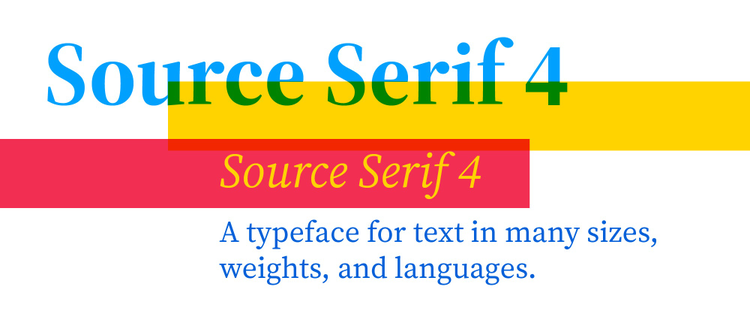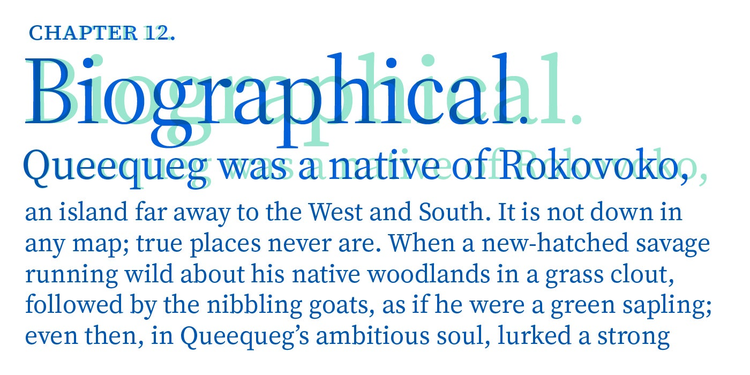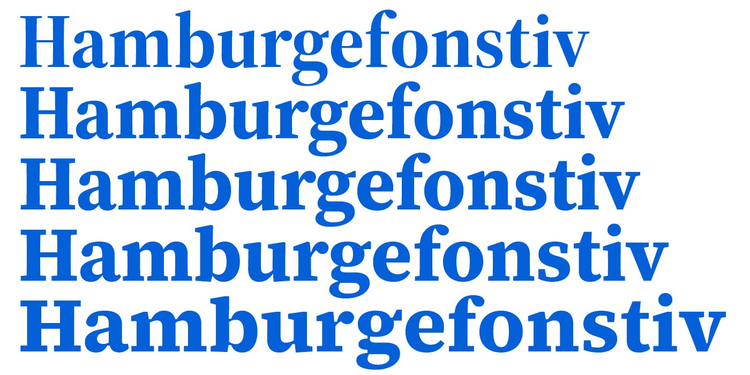Source Serif 4 from Adobe Originals is an open-source typeface for setting text in many sizes, weights, and languages.
Source Serif 4 is an open-source typeface for setting text in many sizes, weights, and languages. A contemporary interpretation of the transitional typefaces of Pierre-Simon Fournier, Source Serif was conceived as a friendly companion to Paul D. Hunt’s Source Sans.
Since their original release, the two Source families have enjoyed wide adaptation both on- and offline. The families embody Adobe’s approach to open-source typeface design, delivering results that are at once aesthetically pleasing and technically excellent.
Open-source fonts are easily accessible to users, and offer type designers the benefit of a quick iteration cycle. In practical terms, this means that adding to the Source projects has been a continual process ever since Source Sans’ first release in 2012. Some updates, though, are more momentous than others.
Source Serif 4 is one such update, marking a substantial addition to the Source Serif family. The introduction of optical sizes enables complex and flexible typography in any of the languages supported, making Source Serif a truly universal typeface. The change is so significant that it even prompted an update to the family name.
Optical sizes
Source Serif 4 has five optical sizes, or subfamilies. In addition to the basic text-size styles, it now includes Caption, Small Text, Subhead, and Display — bringing the total number of styles to 60. The naming scheme follows the example of other Adobe designs released with optical sizes: Arno, Garamond Premier, and Minion 3, to name but a few.
In the days of metal type, punchcutters cut every point size of a typeface by hand. This practice of creating size-specific type waned with the shift to phototypesetting and, more recently, with the advent of digital type. One of the advantages of digital type is infinite scalability. No matter how large or small a given font is set, all of the details are there — the only limit is the fidelity of the output device. This flexibility comes at a cost, though: it is simply not possible for a single font to look and work great at any size.
Typographers know that a large headline will probably require tighter spacing, while small type needs the opposite treatment: letter spaces and word spaces need to be opened up to preserve readability. Those adjustments help overcome the inherent limitations of type designed for a single size. Still, when using only a single style, fine details may disappear when too small, whereas sturdy elements may look unrefined when set large.
Dedicated optical sizes allow typographers to overcome these issues: all formal design decisions — not just spacing, but also letter proportions and shape details — have been tailored to a specific application size.
By observing the way a single letter changes across optical sizes, you can see the sorts of decisions made to compensate for varying output scenarios. While the letter maintains the same stylistic disposition throughout, the size variations reveal varied treatment; from the sturdy, simplified details and optical compensations visible in the Caption style, the letterform morphs into an elegantly swelling high-contrast variant with fine details in the Display style.
So how do you know which optical size to choose? It’s important to realize that these subfamily names only serve as a suggestion — an idea of what the intended usage size might be; they don’t prescribe a given point size. When designing for print, the “correct” optical size depends on viewing distance and output mechanism. On the web, you can use CSS to associate the optical size with your chosen point size.
For an easy, hands-on way to understand the effect of optical sizes, visit Nick Sherman’s V-Fonts and experiment with different slider settings.
And for in-depth technical information about Source Serif (or any font, really), check out Roel Nieskens’ site Wakamai Fondue and drop a variable font file on the interface — it’s like an X-ray for fonts! Added bonus: the site autogenerates CSS code for implementing the variable font on the web.
Where is Source Serif Pro?
Source Serif 4 is the latest and best version of Source Serif; there is no more “Pro.” For one thing, the meaning conveyed by the “Pro” label is no longer relevant. “Pro” was originally attached to OpenType fonts to indicate their extended language coverage. Because Source Serif’s character set now far exceeds former “Pro” standards, the label has become gratuitous.
Furthermore, adding optical sizes required a reassessment of spacing, proportions, and kerning decisions in all masters. We also shifted an intermediate master to clean up the variable font design space. While care was taken to keep the existing styles largely equivalent to previous releases, reflow of existing documents is likely. For these reasons, we decided to change the family name from Source Serif Pro to Source Serif 4.
The future
What is next for Source Serif now that this big update is out?
GitHub’s issue tracker has been a helpful indicator of the community’s needs. Since multiple requests for adding phonetic characters have been filed, extending the family to AL-5 (the largest Latin character set defined by Adobe) seems like a logical next step. Personally, I would like to see an extension toward typesetting African languages, an area greatly underserved by many fonts.
Acknowledgments
From a technical standpoint, this extension represents an enormous amount of work, requiring increasing the design space from 6 to 18 master designs while keeping them all in sync. This would have been difficult or even impossible without outside help.
I would like to thank Google Fonts and Dave Crossland for their ongoing collaboration and for suggesting this project, which allowed me to work with two excellent designers: Reymund Schroeder took on the responsibility of drawing the caption-sized masters, while Thomas Thiemich did excellent work on the display sizes.
A big open-source project has many contributors. I would be remiss not to mention the excellent contributions of Irene Vlachou and Emilios Theofanous, who were tasked with drawing the Greek Italics back in 2019.
In addition to listing all of the contributors and their respective roles, the new specimen page for Source Serif 4 serves as an informative database of marsupials and other small mammals — while exemplifying how optical sizes can be used.







